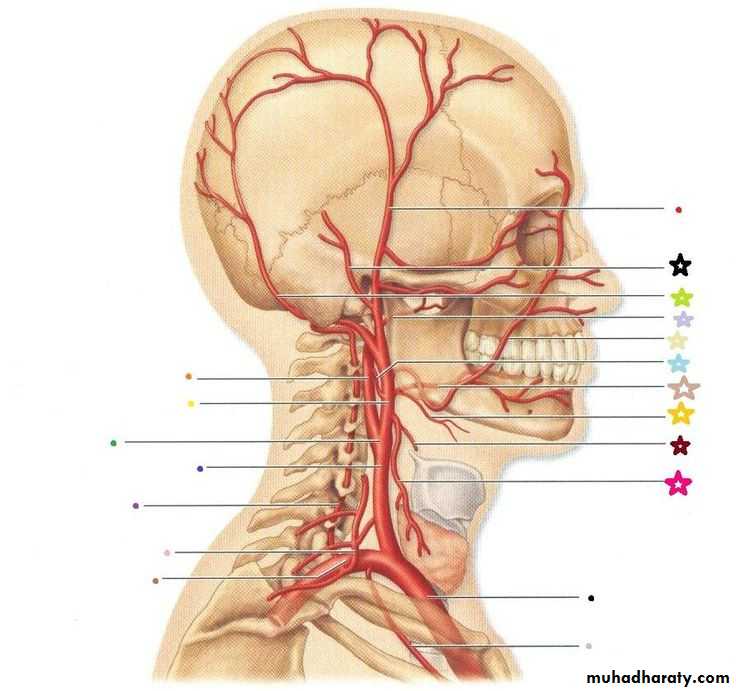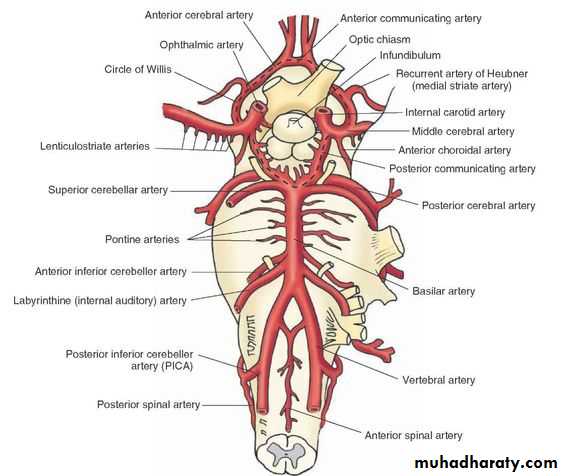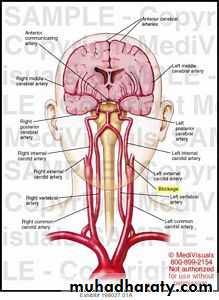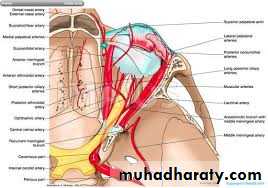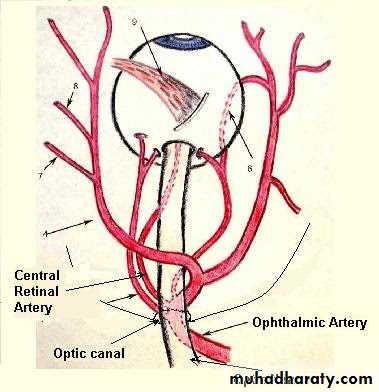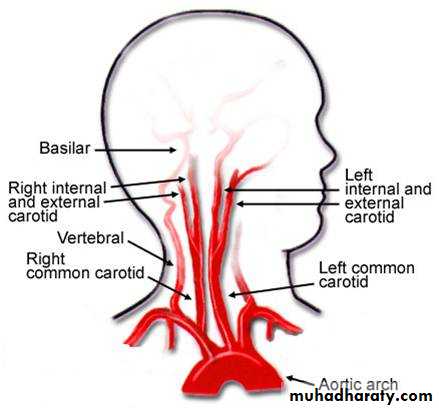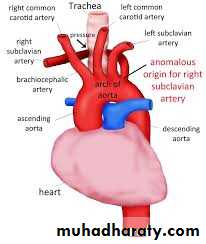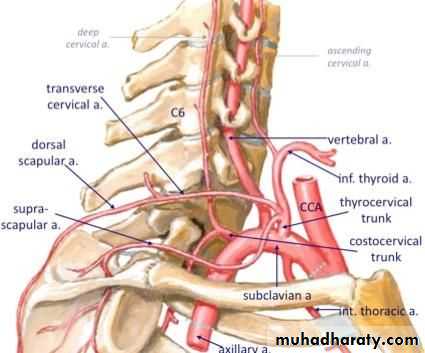Internal Carotid Artery
The internal carotid artery begins at the bifurcation of the common carotid artery at the level of the upper border of the thyroid cartilage. It supplies the brain, the eye, the forehead, and part of the nose. The artery ascends in the neck embedded in the carotid sheath with the internal jugular vein and vagus nerve. At first it lies superficially; it then passes deep to the parotid salivary glandThe internal carotid artery leaves the neck by passing into the cranial cavity through the carotid canal in the petrous part of the temporal bone. It then passes upward and forward in the cavernous venous sinus (without communicating with it). The internal carotid artery then inclines backward, lateral to the optic chiasma , and terminates by dividing into the anterior and the middle cerebral arteries.
Relations of the Internal Carotid Artery in the Neck
Anterolaterally : Below the digastric lie the skin, the fascia, the anterior border of the stemocleidomastoid, and the hypoglossal nerve. Above the digastrics lie the stylohyoid muscle, the stylopharyngeus muscle, the glossopharyngeal nerve, the pharyngeal branch of the vagus, the parotid gland, and the external carotid artery.Posteriorly: The sympathetic trunk , the longus capitis muscle, and the transverse processes of the upper three cervical vertebrae.
Medially: The pharyngeal wall and the superior laryngeal nerve .
Laterally: The internal jugular vein and the vagus nerve.
Branches of the Internal Carotid Artery :
There are no branches in the neck .Many important branches, however, are given off in the skull .
Ophthalmic Artery :
The ophthalmic artery arises from the internal carotid artery as it emerges from the cavernous sinus . It passes forward into the orbital cavity through the optic canal, and it gives off the central artery of the retina, which enters the optic nerve and runs forward to enter the eyeball. The central artery is an end artery and the only blood supply to the retina.
Posterior communicating artery
The Posterior communicating artery runs backward to join the posterior cerebral artery.Anterior Cerebral Artery
The anterior cerebral artery is a terminal branch of the internal carotid artery. It passes forward between the cerebral hemispheres and supply the medial and the super lateral surfaces of the cerebral hemisphere. It is joined to the artery of the opposite side by the anterior communicating artery.Middle Cerebral Artery
The middle cerebral artery is the largest terminal branch of the internal carotid artery and it runs laterally in the lateral cerebral sulcus of the brain. It supplies the entire lateral surface of the cerebral hemisphere except the narrow strip along the superolaterat margin (which is supplied by the anterior cerebral artery) and the occipital pole and inferolateral surface of the hemisphere (both of which are supplied by the posterior cerebral artery).Circle of Willis :
The circle of Willis lies in the subarachnoid space at the base of the brain. It is formed by the anastomosis between the branches of the two internal carotid arteries and the two vertebral arteries. The anterior communicating, anterior and posterior cerebral, and posterior communicating are all arteries that contribute to the circle.Cortical and central branches arise from the circle and supply the brain.
Subclavian Arteries
Right Subclavian ArteryThe right subclavian artery arises from the brachiocephalic artery, behind the right sternoclavicular joint. It arches upward and laterally over the pleura and between the anterior scalene and medius scalene muscles. At the outer border of the 1st rib, it becomes the axillary artery.
Left Subclavian Artery
The left subclavian artery arises from the arch of the aorta in the thorax. It ascends to the root of the neck and then arches laterally in a manner similar to that of the right subclavian artery. The scalenus anterior muscle passes anterior to the artery on each side and divides it into three parts.First Part of the Subclavian Artery
The first part of the subclavian artery extends from the origin of the subclavian artery to the medial border of the scalenus anterior muscle. This part gives off the vertebral artery, the thyrocervical trunk, and the internal thoracic artery.Branches
1. The vertebral artery ascends in the neck through the foramina in the transverse processes of the upper six cervical vertebrae. It passes medially above the posterior arch of the atlas and then ascends through the foramen magnum into the skull. On reaching the anterior surface of the medulla oblongata of the brain at the level of the lower border of the pons, it Joins the vessel of the opposite side to form the basilar artery .The basilar artery ascends in a groove on the anterior surface of the pons. It gives off branches to the pons, the cerebellum, and the internal ear. It finally divides into the two posterior cerebral arteries. On each side, the posterior cerebral artery curves laterally and backward around the midbrain.
Branches in the neck: Spinal and muscular arteries
2. The thyrocervical trunk is a short trunk that gives off three terminal branchesA. The inferior thyroid artery ascends to the posterior surface of the thyroid gland, where it is closely related to the recurrent laryngeal nerve. It supplies the thyroid and the inferior parathyroid glands.
B. The superficial cervical artery is a small branch that crosses the brachial plexus.
C. The suprascapular artery runs laterally over the brachial plexus and follows the suprascapular nerve onto the back of the scapula.
3. The internal thoracic artery descends into the thorax behind the 1st costal cartilage and in front of the pleura. It descends vertically one fingerbreadth lateral to the sternum; in the 6th intercostal space, it divides into the superior epigastric and the musculophrenic arteries.
Second Part of the Subclavian Artery
The second part of the subclavian artery lies behind the scalenus anterior muscle.Branches
The costocervical trunk runs backward over the dome of the pleura and divides into the superior intercostals artery, which supplies the 1st and the 2nd intercostal spaces, and the deep cervical artery, which supplies the deep muscles of the neck.
Third Part of the Subdavian Artery
The third part of the subclavian artery extends from the lateral border of the scalenus anterior muscle across the posterior triangle of the neck to the lateral border of the 1st rib, where it becomes the axillary artery. Here, in the root of the neck, it is closely related to the nerves of the brachial plexus.Branches The third part of the subclavian artery usually has no branches.
Veins of the Head and Neck
The veins of the head and neck may be divided into1. The veins of the brain, venous sinuses, diploic veins, and emissary veins
2. The veins of the scalp, face, and neck
Veins of the Brain
The veins of the brain are thin walled and have no valves. They consist of the cerebral veins, the cerebellar veins, and the veins of the brainstem, all of which drain into the neighboring venous sinuses.Venous Sinuses
The venous sinuses are situated between the periosteal and the meningeal layer of the dura mater. They have thick, fibrous walls, but they possess no valves. They receive tributaries from the brain, the skull bones, the orbit, and the internal ear. The venous sinuses include the superior and inferior sagittal sinuses, the straight sinus, the transverse sinuses, the sigmoid sinuses, the occipital sinus, the cavernous sinuses, and the superior and inferior petrosal sinuses.Diploic Veins
The diploic veins occupy channels within the bones of the vault of the skull.Emissary Veins
The emissary veins are valve-less veins that pass through the skull bones. They connect the veins of the scalp to the venous sinuses (and are an important route for the spread of infection).
Veins of the Face and the Neck
1. Facial Vein
The facial vein is formed at the medial angle of the eye by the union of the supraorbital and supratrochlear veins. It is connected through the ophthalmic veins with the cavernous sinus. The facial vein descends down the face with the facial artery and passes around the lateral side of the mouth. It then crosses the mandible, is joined by the anterior division of the retromandibular vein, and drains into the internal jugular vein.
2. Superficial Temporal Vein
The superficial temporal vein is formed on the side of the scalp. It follows the superficial temporal artery and the auriculotemporal nerve and then enters the parotid salivary gland, where it joins the maxillary vein to form the retromandibular vein.3. Maxillary Vein
The maxillary vein is formed in the infratemporal fossa from the pterygoid venous plexus. The maxillary vein joins the superficial temporal vein to form the retromandibular vein.4. Retromandibular Vein
The retromandibular vein is formed by the union of the superficial temporal and the maxillary veins. On leaving the parotid salivary gland, it divides into an anterior branch, which joins the facial vein, and a posterior branch, which joins the posterior auricular vein to form the external jugular vein.5. External Jugular Vein
The external Jugular vein Is formed behind the angle of the jaw by the union of the with the posterior division of the retromandibular vein.It descends across the stemocleidomastoid muscle and beneath the platysma muscle, and it drains into the subclavian vein behind the middle of the clavicle.6. Anterior Jugular Vein
The anterior jugular vein descends in the front of the neck close to the midline. Just above the sternum, it is joined to the opposite vein by the jugular arch. The anterior jugular vein joins the external jugular vein deep to the stemodeidomastoid muscle.
7. Internal Jugular Vein
The internal jugular vein is a large vein that receives blood from the brain, face, and neck . It starts as a continuation of the sigmoid sinus and leaves the skull through the jugular foramen. It then descends through the neck in the carotid sheath lateral to the vagus nerve and the internal and common carotid arteries. It ends by joining the subclavian vein behind the medial end of the clavicle to form the brachiocephalic vein. Throughout its course, it is closely related to the deep cervical lymph nodes. The vein has a dilatation at its upper end called the superior bulb and another near its termination called the inferior bulb. Directly above the inferior bulb is a bicuspid valve.Relations of the Internal Jugular Vein
Anterolaterally: The skin, the fascia, the stemocleidomastoid, and the parotid salivary gland. Its lower part is covered by the stemothyroid, stemohyoid, and Omohyoid muscles, which intervene between the vein and the stemocleidomastoid. Higher up, it is crossed by the stylohyoid, the posterior belly of the digastric, and the spinal part of the accessory nerve. The chain of deep cervical lymph nodes runs alongside the vein.
Posteriorly: The transverse processes of the cervical vertebrae, the levator scapulae,the scalenus medius, the scalenus anterior, the cervical plexus, the phrenic nerve, the thyrocervical trunk, the vertebral vein, and the first part of the subclavian artery. On the left side, it passes in front of the thoracic duct.
Medially: Above lie the internal carotid artery and the 9th, 10th, ll th, and 12th cranial nerves. Below lie the common carotid artery and the vagus nerve.
Tributaries of the Internal Jugular Vein
1) Inferior petrosal sinus2) Facial vein
3) Pharyngeal veins
4) Lingual vein
5) Superior thyroid vein
6) Middle thyroid vein
Subclavian Vein
The subclavian vein is a continuation of the axillary vein at the outer border of the 1st rib. It joins the internal jugular vein to form the brachiocephalic vein, and it receives the external jugular vein. In addition, it often receives the thoracic duct on the left side and the right lymphatic duct on the right.Relations
Anteriorly: The claviclePosteriorly: The scalenus anterior muscle and the phrenic nerve
Inferiorly: The upper surface of the 1st rib
Thank you for listening

